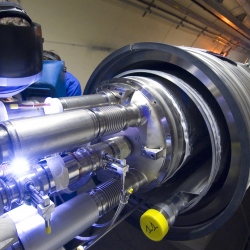
Never heard of astatine? You’re not alone—it’s the rarest naturally-occurring element on Earth.
In fact, if you want to go find some astatine, have a blast: It’s been estimated that, at most, there’s just a couple grams of the stuff in all of the Earth’s crust at any one time, formed from the natural decay of elements such as uranium. But rare as it is, new research from the folks at CERN suggests it could be used in a novel cancer therapy.
The element (number 85 on the Periodic Table, for those of you filling out your charts) was discovered in 1940, when Dale Corson decided to bombard bismuth with alpha particles, yielding an isotope of astatine with a half-life of about eight hours. Some of its less stable isotopes have a half-life of just nanoseconds, making it all but impossible for scientists to learn much at all about the element. Corson and his team decided to name the element after the Greek word for "unstable."
But, as they tend to do, scientists at CERN have a solution for seemingly impossible problems: Using their fancy radioactive isotope facility, known as ISOLDE, which features a laser spectroscope able to take specific measurements of molecules in nanoseconds, they’ve been able to study the atomic structure of astatine for the first time. And it turns out the stuff might be ideal for a new type of cancer therapy.
